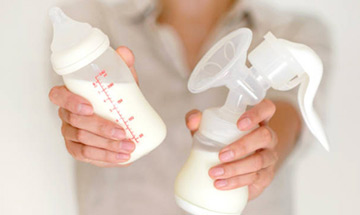When To Pump Up
Breastfeeding as much as you can is recommended because it’s the best way you can feed a baby. We understand that not every person can give their child breastfeeding schedule on-demand 24/7, so if you’re looking to provide your child with ample nutrition, a breast milk pump is one of the best ways that you can do this. There are many reasons using a breast pump is good, so let’s take a look at some of them in this breast pumping guide. Ready? Let’s get going!Tip No 1: Following Set Routines
Getting routine into the day is one of the most important breast pumping tips you’ll need doing. Put your tool in the same place, use the same chair and drink the same drink. Get your equipment working every time. Chill out and use some calming techniques in order to help you relax away and start. Make sure that you include milk ejection reflexes in your routine.Tip No 2: Breast Massage Before Use

Tip No 3: Priming Your Tool
If you’re wondering about how to increase milk supply when pumping, it’s important to think about preparation. When you’re sitting down, make sure you get some glasses of water down before you begin. You’ll notice large differences when you pump breasts, especially when pumping at night.Tip No 4: Get Your Mind In the Zone

Tip No 5: Look at a Picture of Your Little Child
Just like we’ve talked about with visualization, it can be difficult to get in the mood, so this is one of those breast pumping hacks that do the job. Take a look at a picture of your little toddler as you work the tool. Soon milk will be flowing with ease. If you can’t find a picture, try stimulating your senses with a piece of fabric they wear or look at toys they love playing with.Tip No 6: Make Sure You Know What Baby is Doing
You won’t want potentially dangerous situations on your hands. Know what your baby is doing at all times. Make calls to your sitter in order to find out what your toddler is doing moments before you begin.Tip No 7: Listen to Some Music

Tip No 8: Work with Lower Suction Settings
If you’re experiencing problems, try experimenting with suction settings. Go for a lower setting if you ever find your nipples becoming sore. Be sure that nipples don’t run against flange when using the tool. This is one of those tips for pumping you can’t live without.Tip No 9: Applying Emollient
When wondering about how to use a breast pump, think about applying emollient like Lansinoh which can heal and soothe soreness in nipples. Soften your emollient between fingertips and then pat it onto your nipples. It will help you feel relief from your discomfort.Tip No 10: Use as of When Your Baby Needs It
If your baby thinks they’re fed up with this world, they probably haven’t had enough milk, so how often should I pump? Make sure you feed them every four hours. When you’re worried about not producing enough, just use more frequently.Tip No 11: Adding Extra Morning Sessions

Tip No 12: Checking the Pump
It is often that tips for pumping breast milk are kind of obvious, but important nonetheless. Make sure you ask yourself if you’re putting the tool together properly. While you use it, check for maintenance. Are there parts of the seal that have worn out? Check with the manufacturer and on their website – they should have a contact number and some instructions. If renting your tool from some lactation consultant, they could certainly advise you about replacing any worn down parts.Tip No 13: Nursing
When pumping, try to use on one breast whilst also feeding your baby with glass baby bottles. As you do this you may notice that child triggering bodily reflexes helps eject milk, thus helping you collect milk very easily. For manual breast pumping tips, you may want to reject this because it’s difficult. Much easier is using an electric tool.Tip No 14: Double Pumping

Tip No 15: Tool Not Working? Try a Different One
Pumping breast milk tips work better with top breast pumps. If you feel that your tool isn’t working for you, trade it in for a higher quality tool! It may be more money, but it certainly will be money well spent. Differences between hospital-grade pumps and a best pumping bra in 2023 pump are remarkable.Tip No 16: Wearing Outfits that Bring Easy Access
Here we’ve got something unrelated to breast pumping techniques – wear a loose top! If you find it difficult to nurse in a discreet manner, you can wear something loose so that your top can be pulled up from the lower end. Invest in a few goods looking nursing tops which have a camouflaged opening where breasts are – this can significantly simplify both nursing and pumping.Tip No 17: Double It Using Just One Hand

Get Going
That’s just about it from us, so get out there and start. Hopefully, with these tips for breast pump use and our advice, you can get the most out of this for your child. Best of luck! Have you had any experience with this tool before? Anything we’ve left out? Please send parenthoodroutine.com your comments and thoughts below.Contents
- 1 When To Pump Up
- 2 Tip No 1: Following Set Routines
- 3 Tip No 2: Breast Massage Before Use
- 4 Tip No 3: Priming Your Tool
- 5 Tip No 4: Get Your Mind In the Zone
- 6 Tip No 5: Look at a Picture of Your Little Child
- 7 Tip No 6: Make Sure You Know What Baby is Doing
- 8 Tip No 7: Listen to Some Music
- 9 Tip No 8: Work with Lower Suction Settings
- 10 Tip No 9: Applying Emollient
- 11 Tip No 10: Use as of When Your Baby Needs It
- 12 Tip No 11: Adding Extra Morning Sessions
- 13 Tip No 12: Checking the Pump
- 14 Tip No 13: Nursing
- 15 Tip No 14: Double Pumping
- 16 Tip No 15: Tool Not Working? Try a Different One
- 17 Tip No 16: Wearing Outfits that Bring Easy Access
- 18 Tip No 17: Double It Using Just One Hand
- 19 Get Going










